Jerusalem - Outside the Walls
If you came to this page directly, you might wish to read a page with an introduction to this section first or start with Jerusalem - The Walls.
The guide began to give name and history to every bank and boulder we came to: "This was the Field of Blood; these cuttings in the rocks were shrines and temples of Moloch; here they sacrificed children; yonder is the Zion Gate; the Tyropean Valley, the Hill of Ophel; here is the junction of the Valley of Jehoshaphat - on your right is the Well of Job." We turned up Jehoshaphat. The recital went on. "This is the Mount of Olives; this is the Hill of Offense; the nest of huts is the Village of Siloam; here, yonder, every where, is the King's Garden; under this great tree Zacharias, the high priest, was murdered; yonder is Mount Moriah and the Temple wall; the tomb of Absalom; the tomb of St. James; the tomb of Zacharias; beyond, are the Garden of Gethsemane and the tomb of the Virgin Mary; here is the Pool of Siloam, and ..."
Mark Twain - The Innocents Abroad - 1869
Twain soon had enough of visiting the outskirts of Jerusalem and he did not care to give his readers a detailed description of them.
 | ||
The church containing the supposed tombs of Sta Anna, the Virgin, St Joseph and St Joachim (..) stands about 300 paces east south east of the Golden Gate and has its door neatly arched with stone. On going in we descended a wide staircase with forty eight steps to the church below (..). To the right on entering is the grotto containing it is said the Virgin's tomb. (..) Half way down the staircase in a recess to the right on entering the church is the tomb called that of St Anne. To the left of it at right angles is another called the tomb of St Joachim. Opposite to these two on the other side of the stairs is the supposed tomb of St Joseph standing in a small arched grotto as do the two opposite. On all these tombs the Greek told me remain the original stones that covered them and there is an altar over all four. The Virgin's tomb is in a natural grotto with a flat roof, but the recesses containing the other three are built and arched.
William Turner - Journal of a Tour in the Levant - 1820
Turner felt his duty to visit all the holy sites around Jerusalem, but his account indicates he had great doubts about the likelihood of what he was told.
 | ||
Between east and south east of the east wall the valley is filled with tombs of the Jews which are common unadorned stones engraved with the name of the dead in Hebrew. I saw no distinction of rank in the tombs which all lie flat on the ground. W. Turner
The Mount of Olives stands opposite the eastern walls of Jerusalem. The Jewish cemetery is very large because many Jews came to Jerusalem to die and be buried in holy ground.
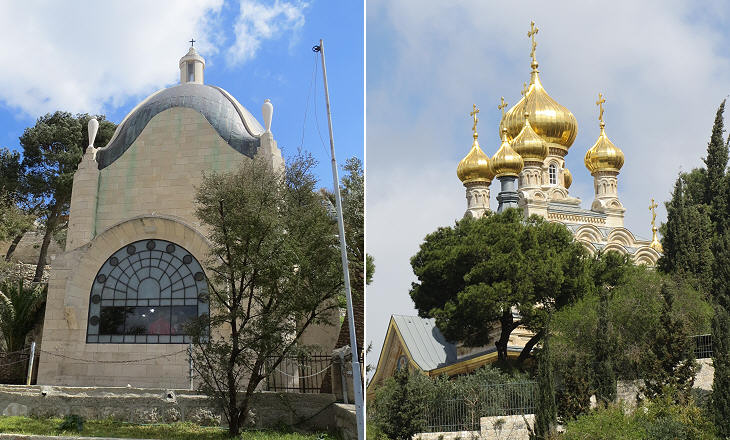 | ||
In the late XIXth century and during the XXth century several churches of very different styles were built on the Mount of Olives. Germany, France, Italy, Russia and other nations financed the construction of these churches (and of hospitals and other facilities) as a sign of their political power. Germany was an ally of the Ottoman Empire and German companies were involved in the development of its railway system. Russian tsars regarded themselves as the protectors of the Orthodox. Italy and France had strong Catholic parties.
 | ||
I ascended Mount Olivet as I have often done during my stay here to enjoy the view of Jerusalem and to compare Tasso's description of it in the 55th and following verses of his third Canto (of Jerusalem Delivered) which is still the best that can be given. This mountain affords the best possible view of Jerusalem as it overlooks it close.W. Turner
And when he was come near, he beheld the city, and wept over it, saying "If thou hadst known, even thou, at least in this thy day, the things which belong unto thy peace! but now they are hid from thine eyes".
Luke 19:41-42
Dominus Flevit has the shape of a tear in memory of the event which took place there.
 | ||
The ruins of a Byzantine church were unearthed during the excavations for building Dominus Flevit. The church had an elegant mosaic floor decorated with fruits. An ossuary was found near the church, thus showing that the practice of using the Mount of Olives as a cemetery was very old.
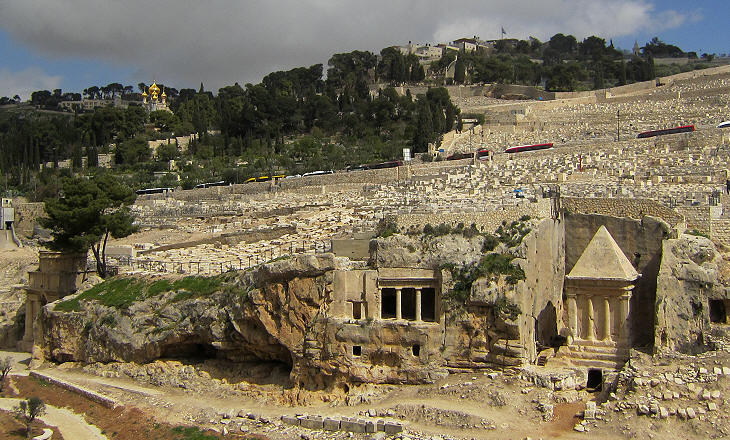 | ||
This page is structured as a clockwise walk around Jerusalem starting from Lion Gate in the eastern walls and ending at Damascus Gate in the northern walls.
After having seen Jerusalem from Dominus Flevit I moved across the Kidron Valley to the south-eastern corner of the walls to have a view of the Mount of Olives.
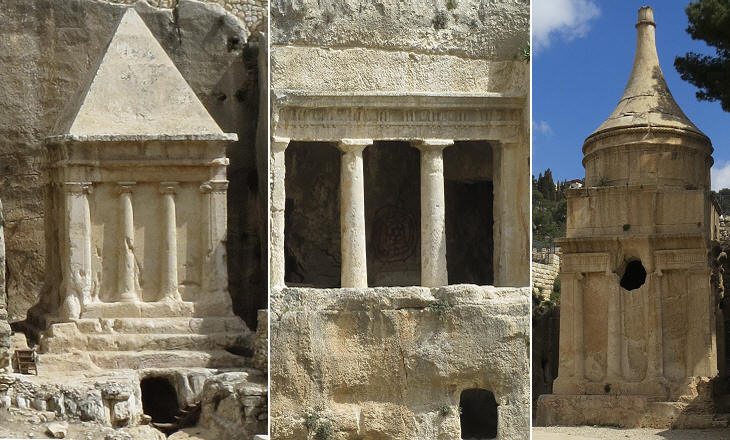 | ||
We walked (..) to a tomb cut from the rock called, I know not why, the tomb of Zachariah. (..) A cavity is scooped from the rock forming three sides of a square each side thirty seven feet ten inches broad. The tomb also cut from the solid rock thus and left in the middle with a passage round it is nineteen feet ten inches square and about thirty five feet high of which half goes to a cupola ending in a point. It is adorned with columns about fifteen feet high with capitals cut in bas relief and the architrave is decked with ornaments. All is cut from the rock and must have cost immense labour.
On the north side of the rock that incloses the tomb we entered by a small door into a cave about fifty feet long ten broad and fifteen high where it is said the Apostles hid themselves after Jesus was taken by Judas. This cave all cut from the rock has two entrances one at the south end from the site of the tomb of Zachariah and the other at the north west corner adorned with two columns; from this latter however there is no exit as it opens on a perpendicular fall of the rock about thirty feet high.
(..) About 120 paces north of the supposed tomb of Zachariah (..) is another building hewn from the rock, which is not here so high as at the tomb of Zachariah, called the tomb of Absalom. He certainly was not buried here, but it is not impossible that this may be the pillar which he reared in his life time. The three sides of the rock scooped out to admit this edifice are about the same breadth as at the tomb of Zachariah. The first twenty feet from the ground are hewn out of the rock, but the dome and the square that supports it are built with large stones. It is adorned with columns in bas reliefs like those of the tomb of Zachariah and the architrave is of the same description, but the dome is of a very different shape. W. Turner
 | ||
Although some do believe that the buildings housed the tombs of biblical figures, archaeologists date them Ist century BC or Ist century AD and think they belonged to wealthy unidentified families.
This type of tomb can be broadly defined as Hellenistic as they can be seen in many parts of the Levant (e.g. at Myra), but they call to mind the kumbets of Kayseri, although the latter were built more than a thousand year later.
 | ||
We went out at a gate which looked towards the south south west and immediately before it in the same direction about fifty feet distant was a small Armenian convent into which we entered. In the court of the church grows a small orange tree which is said to occupy the spot where St Peter stood when he denied Christ and at the door of the church twenty one feet distant from the tree the figure of a cock is sculptured on a stone in the wall to mark the pretended place where that bird stood when it accused him. W. Turner
A large Roman Catholic nunnery has replaced the small Armenian convent and a modern group of statues indicates the spot where Peter denied knowing Jesus. Gallicantu means cock's crow and the episode is described in Luke 22: 60-61 (King James version): And Peter said, Man, I know not what thou sayest. And immediately, while he yet spake, the cock crew. And the Lord turned, and looked upon Peter. And Peter remembered the word of the Lord, how he had said unto him, Before the cock crow, thou shalt deny me thrice.
 | ||
The church is located south-west of Sion Gate and it has a commanding view over Haram esh-Sheriff and the southern part of the Kidron valley.
The image used as background for this page shows the weathervane of the church.
 | ||
About the same distance south by west of it (Sion Gate) is a Turkish mosque, the court of which contains what is called the Sepulchre of David and a room in which Christ is said to have eaten the last supper with his disciples.(..) We mounted by a staircase to the top of the mosque which was flat and on the north side of the roof entered a chamber said to be that where our Saviour ate the last Supper with his disciples. It is about fifty feet by thirty and the roof is supported by three large clumsy columns with capitals fancifully ornamented. In one end is a staircase leading to a Turkish house below over which is a small dome supported by a little column of coarse white marble with a capital adorned like those of the other three. W. Turner
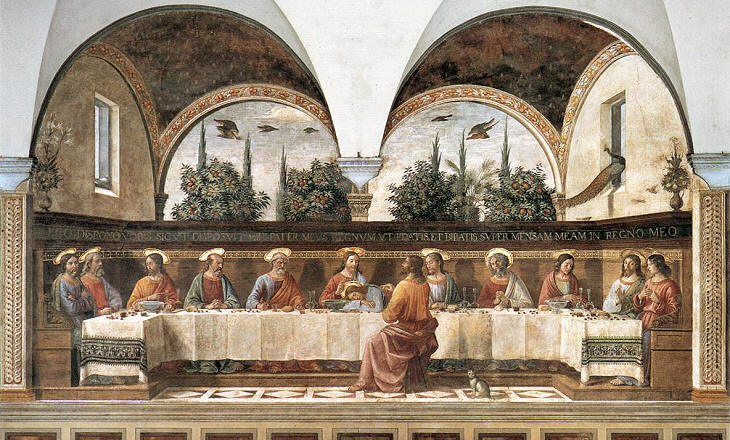 | ||
A Crusader building, standing on the site of a Byzantine church, made up of ancient columns and capitals and retaining some features of a mosque is now worshipped in the lower floor (turned into a synagogue) as the Sepulchre of David and in the upper one as the Hall of the Last Supper.
 | ||
About 100 feet south south west of the Armenian convent is shewn a spot on the mountain where the Virgin is reported to have died. W. Turner
In 1898 Kaiser William II visited Jerusalem and he bought a large piece of land which included the site mentioned by Turner. A very large church designed by Heinrich Renard was completed in 1910. It is yet another example of the eclectic style which prevailed at the time. The Jerusalem YMCA which stands on the hill opposite the Church of the Dormition is another example of eclectic style. It was designed in 1933 by American architect Arthur Loomis Harmon who is best known for having designed the Empire State Building in New York.
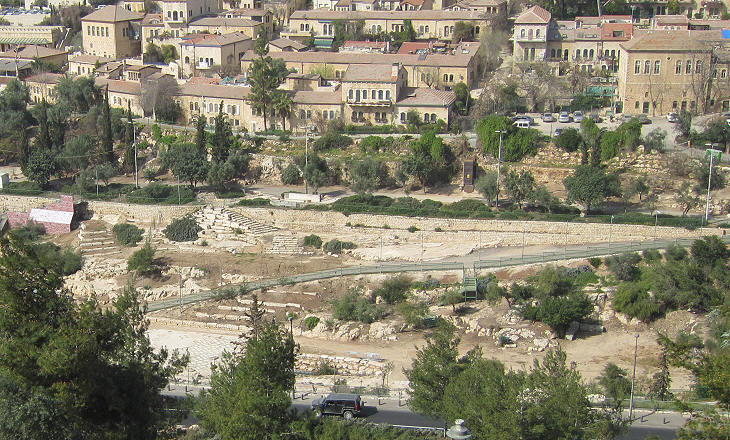 | ||
And they have built the high places of Tophet (you may wish to see that of Carthage), which is in the valley of the son of Hinnom, to burn their sons and their daughters in the fire; which I commanded them not, neither came it into my heart. Jeremiah 7:31 (King James version). Today the valley of Hinnon, aka Gehenna, does not bring to mind apocalyptic views of punishment of the wicked. It housed a water reservoir which was renovated by the Ottomans. Between 1948-67 it marked the border between Israel and Jordan.
 | ||
The first Jewish settlement outside the walls of Jerusalem was promoted by Sir Moses H. Montefiore, a British philantropist who descended from a Jewish family from Leghorn. In order to promote self-sufficiency of the first settlers he built a windmill in 1857. The building has become a landmark of West Jerusalem and a symbol of the simple and hard life of the first settlers. The windmill however proved not to be effective, because Jerusalem does not have many windy days and in 1891 it was phased out.
 | ||
At half past eight we passed the large Greek convent of Sullah half an hour northwest of Jerusalem where it is believed, though even the Catholicks have the modesty to allow that this is not certain, that the wood of the cross was cut. It is a small valley in which still grow a few olive trees. W. Turner
Turner forgot to tell his readers that according to tradition the tree which provided the wood for the cross was planted by Adam and cared for by Abraham. The bell tower was added after Turner visited the monastery, which owing to its isolated location was protected by high walls.
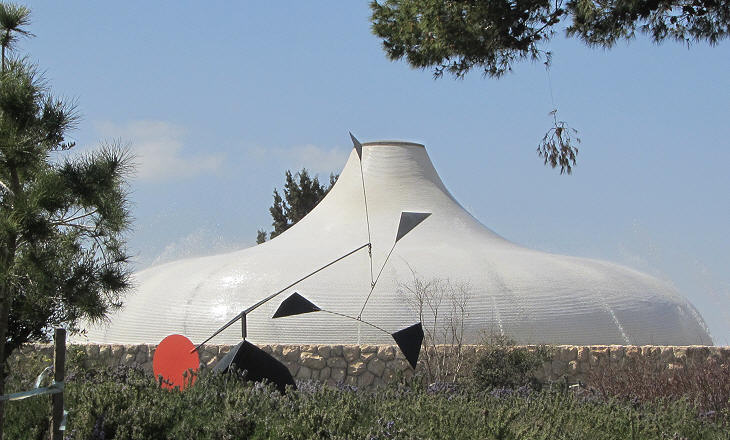 | ||
The hill to the west of the Monastery of the Cross houses the Museum of Israel, actually a complex of various museums including an archaeological one with exhibits from prehistory to the Ottoman period, some of which have been used to illustrate this section.
 | ||
Since 1966, thanks to a donation by James A. de Rothschild, the Parliament (120 members) of Israel meets in a specially designed building near the Museum of Israel.
 | ||
Overall the Old City retains much of its historical aspect and it is not dramatically different from that which Turner and Twain saw. The "View over the Old City of Jerusalem" unfortunately has favoured the construction of expensive developments, such as Mamilla Residences which offer it to their customers. The view of these new developments from the Old City is a real eyesore.
 | ||
All sects of Christians (except Protestants) have chapels under the roof of the Church of the Holy Sepulchre. M. Twain. Maybe the fact that Roman Catholics, Orthodox and Armenians were not prepared to share their ownership of the Holy Sepulchre with the Protestants led General Charles Gordon (aka Gordon of Khartoum) to declare that the real Holy Sepulchre was located outside Damascus Gate. In 1893 the Garden Tomb Association, an independent British trust, was established to preserve and maintain the site. The last page of the leaflet given to visitors has some words of caution: We do not know whether this site was the actual place of the crucifixion, burial and Resurrection of Jesus.
See these other pages on Jerusalem
| The Ancient City | The Walls | The Holy Sepulchre |
| Haram esh-Sheriff | The Four Quarters | The Crusader City |
Move to:Introductory Page
Nimrod Castle
Banias (Caesarea Philippi)
Acre (Akko)
Turner's excursion to Kaifah (Haifa)
Tiberias
Holy sites in Galilee
Nazareth
Jaffa
A Glimpse of Tel Aviv



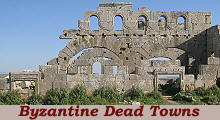
No comments:
Post a Comment